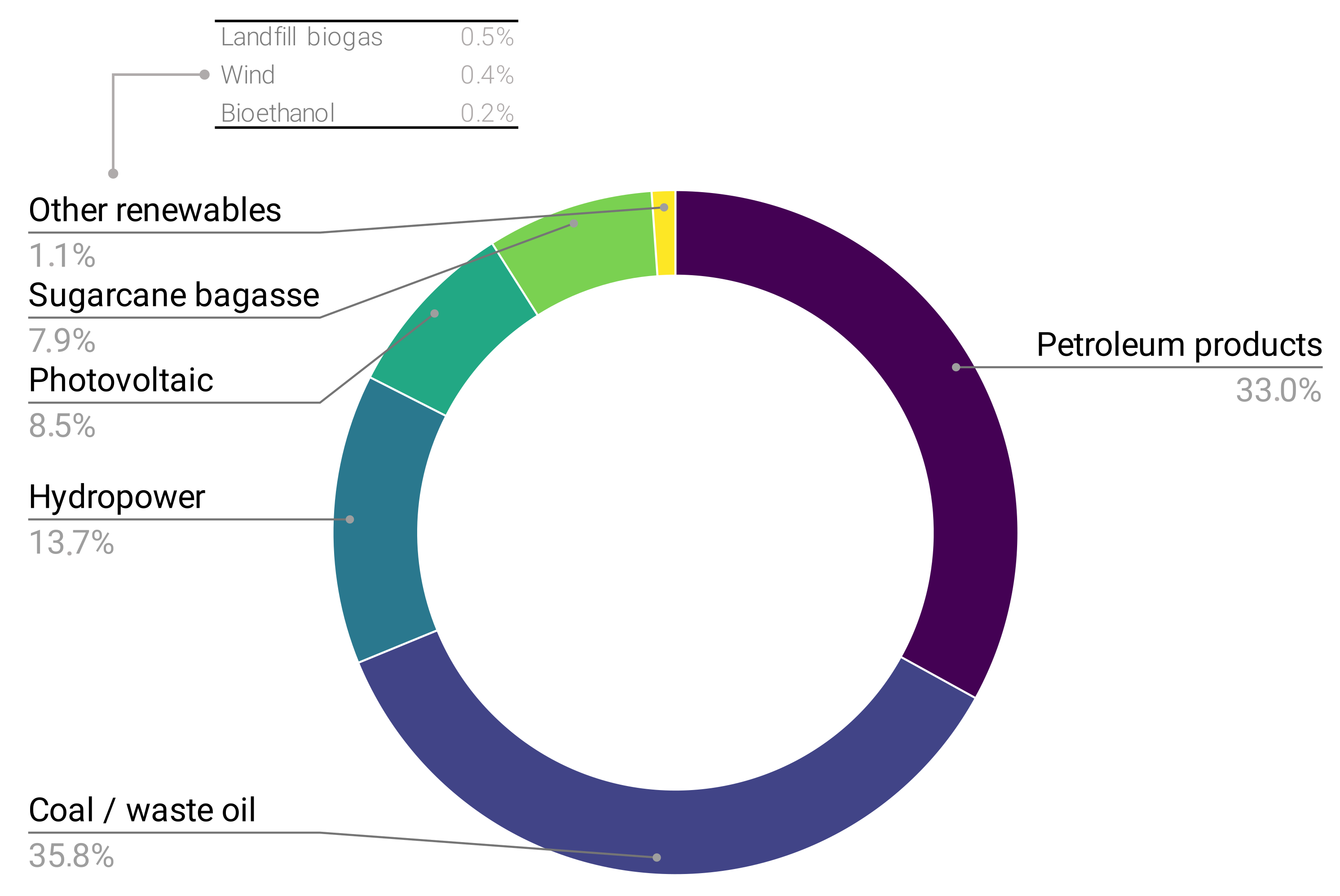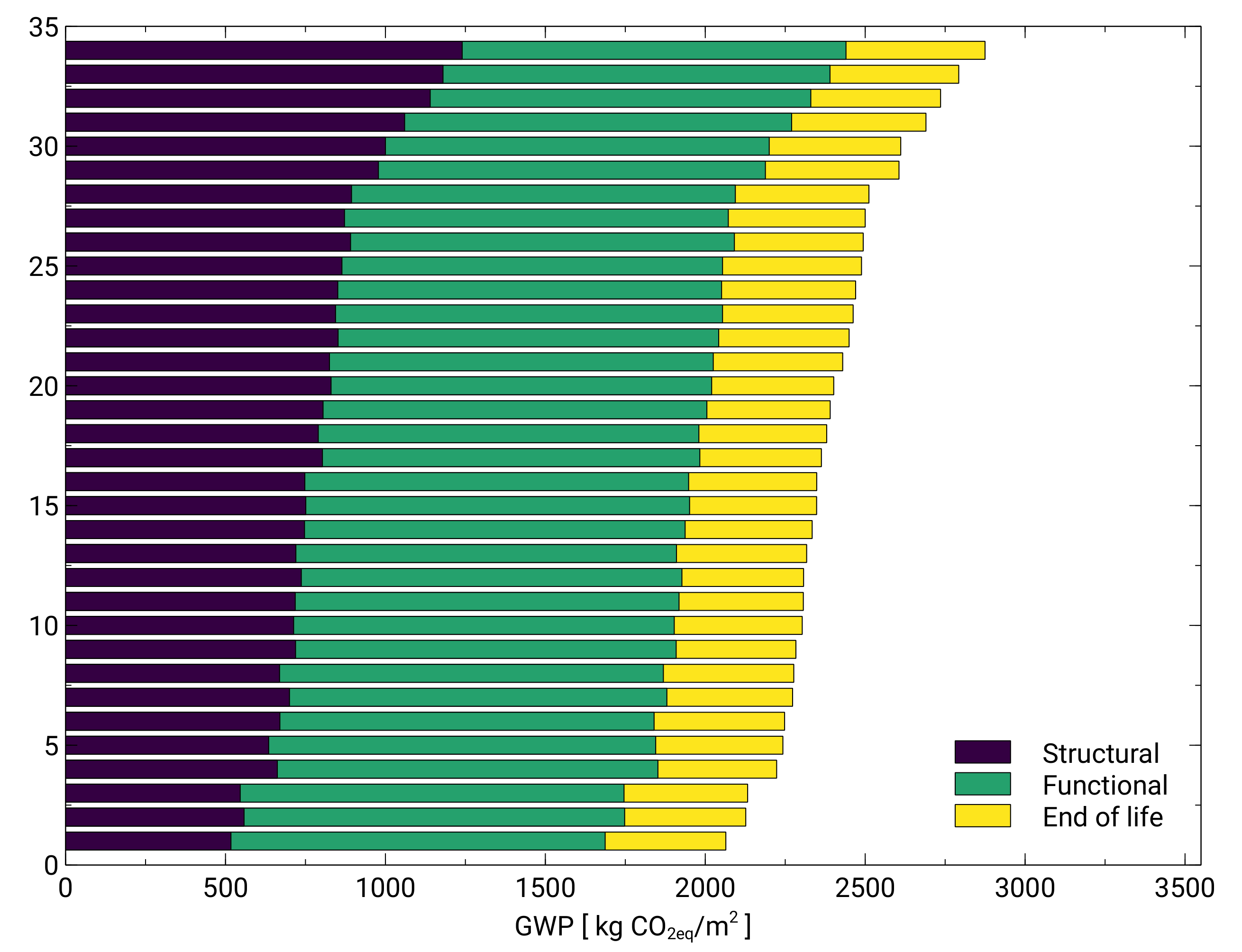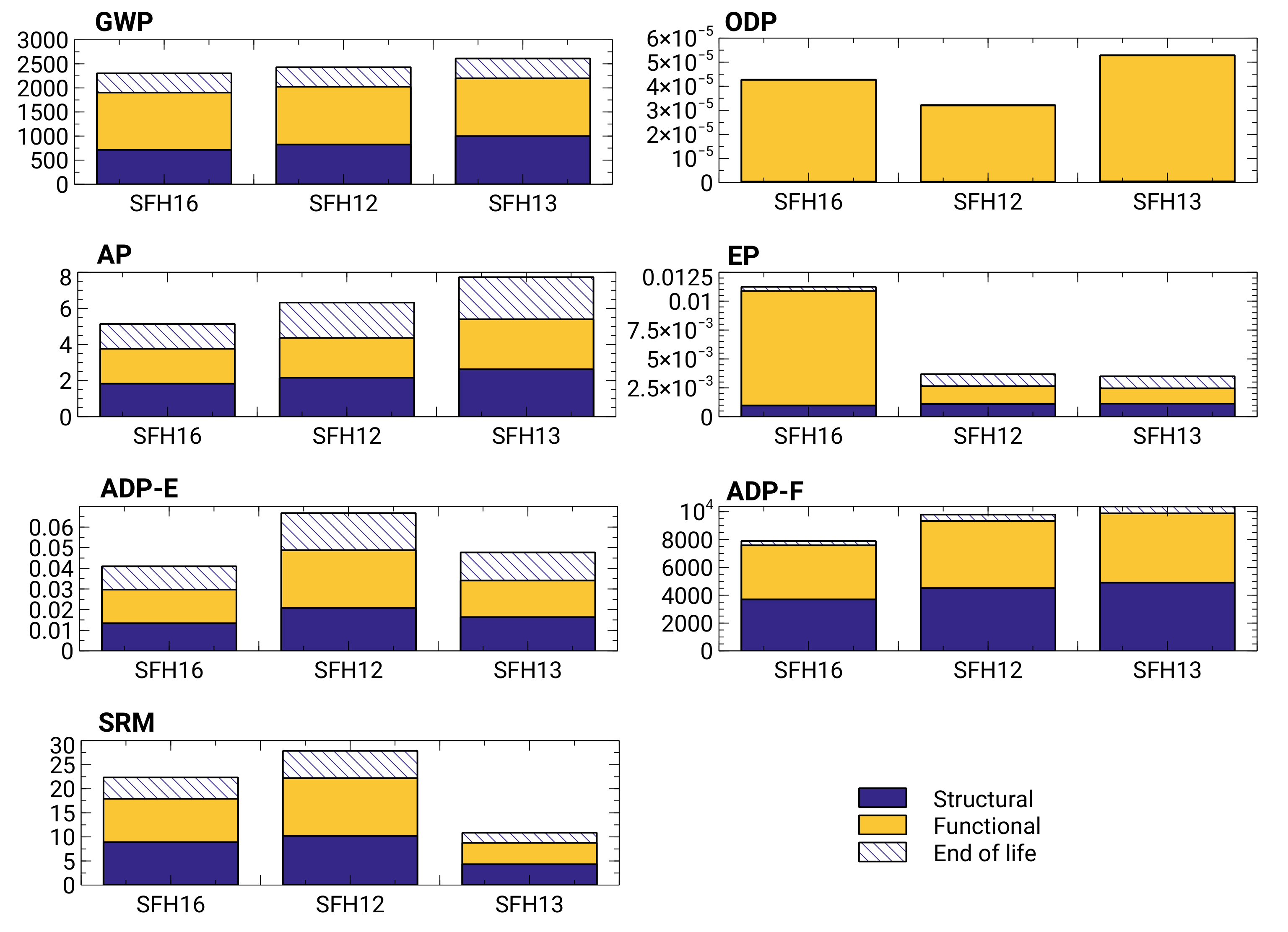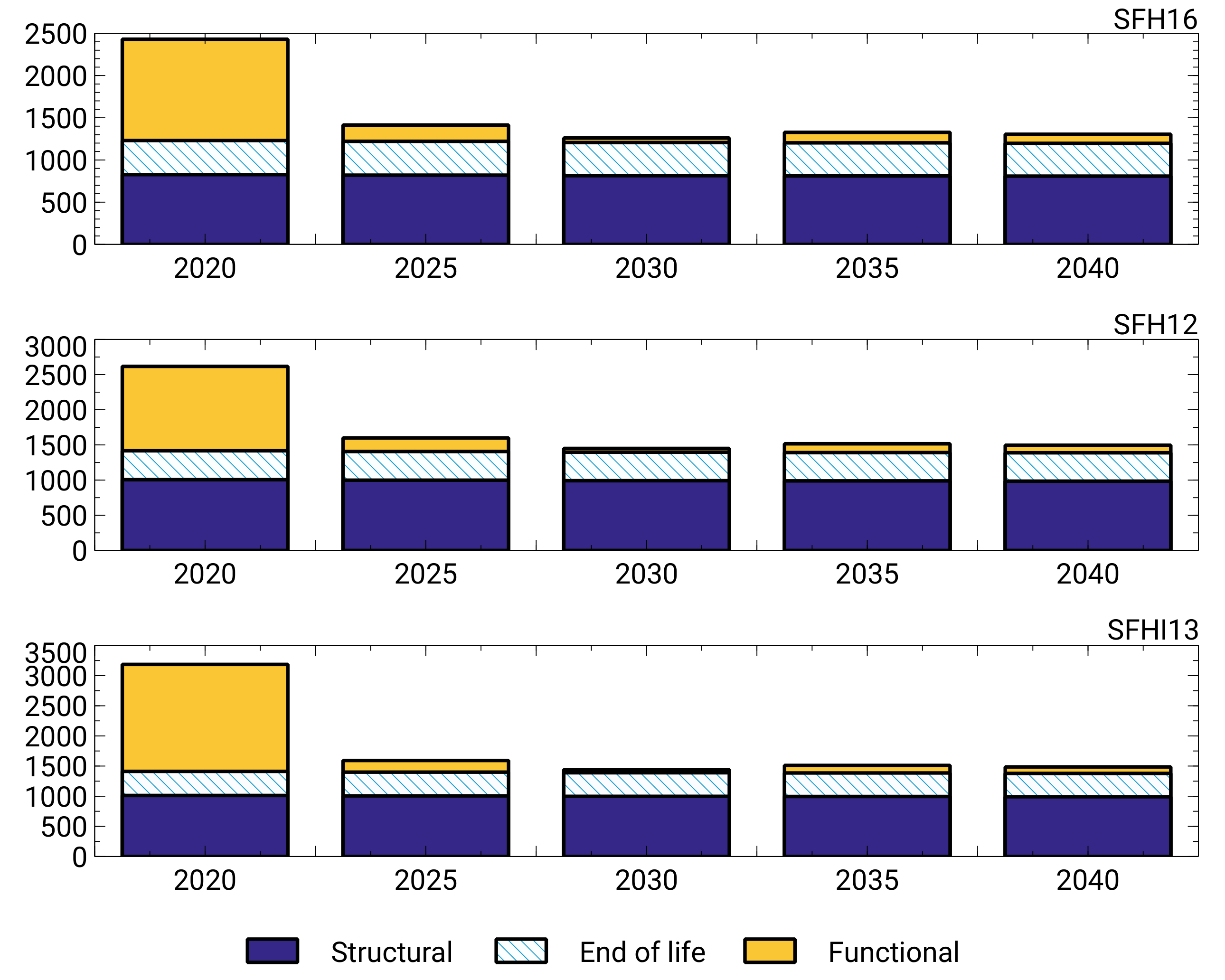Prospective Life Cycle Assessment: Effect of Electricity Decarbonization in Building Sector
Abstract
1. Introduction
1.1. Motivation
1.2. A Brief Literature Review
1.3. Contribution and Aim of the Work
1.4. Organization of the Work
2. The Reunion Island Context
2.1. Geography and Socio-Economic Situation
2.2. Overview of the Building Sector
2.3. Energy Landscape
- 50% of RE in final energy consumption in 2020; and
- energy autonomy of territories in 2030.
3. Material and Methods
3.1. Environmental Assessment
- Global Warming Potential (GWP)—kg eq [42];
- Acidification Potential (AP)-kg eq [43];
- Eutrophication (EP)-kg eq;
- Depletion of the ozone layer (ODP)-kg CFC-11 eq;
- Potential of abiotic resources-elements (ADP-E)-kg Sb eq;
- Potential of abiotic resources-fossil fuels (ADP-F)-MJ;
- Secondary Raw Materials(SRM)-kg.
3.2. Clustering
3.3. Energy Scenario Design
- BAU—This scenario illustrates the current situation of the territory. There is no increase in the share of renewable energy in the mix. The production of hydro, PV, and wind power are left constant.
- Scenarios—Firstly, coal is abandoned in favor of green pulp, and a progressive decrease of HFO plants is modeled until 2029. One of the significant points is the integration of waste recovery in several forms. The first existing aspect that will be developed will be biogas from landfills, despite the low availability of land for new landfills. A second aspect concerns the incineration of Municipal solid waste (MSW) and gasification, which, at the moment, is still in the experimental phase on the island [51,52]. Finally, geothermal energy, which had been neglected for a long time, is again discussed in the plans. Geothermal technology has been integrated into the scenario according to the possibility of a first installation.
4. Results and Discussion
4.1. Environmental Assessment of 34 SFHs
4.2. Typology of the Reunion Houses
4.3. Environmental Impact of Materials
4.4. Overall Indicators Results
4.5. Energy Scenario
- removal of coal in the short term;
- increase in historically available renewable facilities; and
- development of new technologies (“Backstop” approach).
4.6. Effect of Decarbonization of the Electricity Mix
5. Conclusions and Policy Implications
Author Contributions
Funding
Institutional Review Board Statement
Informed Consent Statement
Data Availability Statement
Acknowledgments
Conflicts of Interest
Abbreviations
| ABWA | American bloc wall |
| ADP-E | Abiotic Depletion Potential-elements |
| ADP-F | Abiotic Depletion Potential-Fuels |
| ALBL | Aluminium blinds |
| AP | Acidification Potential |
| BAU | Business-As-Usual |
| CINB | Cinder block |
| COMS | Concrete mortar screed |
| CONP | Concrete paving |
| EFCP | External facade coating type paint |
| EJMR | Exterior joinery type motorized roller shutter |
| En | End-of-life |
| EP | Eutrophication Potential |
| EXTC | External coating |
| FCPL | False ceiling in plasterboard |
| Fu | Functional |
| GWP | Global Warming Potential |
| IFCP | Interior facade coating type paint |
| INTP | Interior plastering |
| ODP | Ozone Depletion Potential |
| PORT | Porcelain tile |
| PURL | Purlins |
| SAED | Solid aluminium entrance door |
| SFH | Single Family House |
| SRM | Secondary Raw Materials |
| STER | Steel roofing |
| WTE | Waste treatment energy |
References
- Intergovernmental Panel on Climate Change. Climate Change: The IPCC Scientific Assessment; Mass: Cambridge, MA, USA, 1990.
- Scandurra, G.; Romano, A.; Ronghi, M.; Carfora, A. On the vulnerability of Small Island Developing States: A dynamic analysis. Ecol. Indic. 2018, 84, 382–392. [Google Scholar] [CrossRef]
- Scandurra, G.; Thomas, A.; Passaro, R.; Bencini, J.; Carfora, A. Does climate finance reduce vulnerability in Small Island Developing States? An empirical investigation. J. Clean. Prod. 2020, 256, 120330. [Google Scholar] [CrossRef]
- Briguglio, L. Economic Vulnerability and Resilience: Concepts and Measurements; University of Malta, Islands and Small States Institute & The Commonwealth Secretariat: Msida, Malta, 2004. [Google Scholar]
- Encontre, P. The Vulnerability and Resilience of Small Island Developing States in the Context of Globalization; Natural Resources Forum; Wiley Online Library: Oxford, UK, 1999; Volume 23, pp. 261–270. [Google Scholar]
- Kuang, Y.; Zhang, Y.; Zhou, B.; Li, C.; Cao, Y.; Li, L.; Zeng, L. A review of renewable energy utilization in islands. Renew. Sustain. Energy Rev. 2016, 59, 504–513. [Google Scholar] [CrossRef]
- Praene, J.P.; Fakra, D.A.H.; Benard, F.; Ayagapin, L.; Rachadi, M.N.M. Comoros’s energy review for promoting renewable energy sources. Renew. Energy 2021, 169, 885–893. [Google Scholar] [CrossRef]
- Surroop, D.; Raghoo, P.; Wolf, F.; Shah, K.U.; Jeetah, P. Energy access in Small Island Developing States: Status, barriers and policy measures. Environ. Dev. 2018, 27, 58–69. [Google Scholar] [CrossRef]
- Nwodo, M.N.; Anumba, C.J. A review of life cycle assessment of buildings using a systematic approach. Build. Environ. 2019, 162, 106290. [Google Scholar] [CrossRef]
- Oduyemi, O.; Okoroh, M.I.; Fajana, O.S. The application and barriers of BIM in sustainable building design. J. Facil. Manag. 2017, 15, 15–34. [Google Scholar] [CrossRef]
- Hong, J.; Shen, G.Q.; Feng, Y.; Lau, W.S.T.; Mao, C. Greenhouse gas emissions during the construction phase of a building: A case study in China. J. Clean. Prod. 2015, 103, 249–259. [Google Scholar] [CrossRef]
- Giesekam, J.; Barrett, J.R.; Taylor, P. Construction sector views on low carbon building materials. Build. Res. Inf. 2016, 44, 423–444. [Google Scholar] [CrossRef]
- Sartori, T.; Drogemuller, R.; Omrani, S.; Lamari, F. A schematic framework for Life Cycle Assessment (LCA) and Green Building Rating System (GBRS). J. Build. Eng. 2021, 38, 102180. [Google Scholar] [CrossRef]
- Ürge-Vorsatz, D.; Eyre, N.; Graham, P.; Harvey, D.; Hertwich, E.; Jiang, Y.; Kornevall, C.; Majumdar, M.; McMahon, J.E.; Mirasgedis, S.; et al. Energy end-use: Buildings. In Global Energy Assessment: Toward a Sustainable Future; Cambridge University Press: Cambridge, UK, 2012; pp. 649–760. [Google Scholar]
- Li, L.; Sun, W.; Hu, W.; Sun, Y. Impact of Natural and Social Environmental factors on Building Energy Consumption: Based on Bibliometrics. J. Build. Eng. 2021, 37, 102136. [Google Scholar] [CrossRef]
- Schwarz, M.; Nakhle, C.; Knoeri, C. Innovative designs of building energy codes for building decarbonization and their implementation challenges. J. Clean. Prod. 2020, 248, 119260. [Google Scholar] [CrossRef]
- Bachtrögler, J.; Fratesi, U.; Perucca, G. The influence of the local context on the implementation and impact of EU Cohesion Policy. Reg. Stud. 2020, 54, 21–34. [Google Scholar] [CrossRef]
- ISO 14040. Environmental Management Life Cycle Assessment—Requirements and Guidelines; Technical Report; Standard International Organization for Standardisation: Geneva, Switzerland, 2006. [Google Scholar]
- Scientific Applications International Corporation; Curran, M.A. Life-Cycle Assessment: Principles and Practice. Available online: https://nepis.epa.gov/Exe/ZyPDF.cgi/P1000L86.PDF?Dockey=P1000L86.PDF (accessed on 30 April 2021).
- Trusty, W. An Overview of Life Cycle Assessments: Part One. Available online: http://nebula.wsimg.com/8e1979caac388783b871756ffc367615?AccessKeyId=1C31A3B4B1A73412F089&disposition=0&alloworigin=1 (accessed on 30 April 2021).
- Sharma, A.; Saxena, A.; Sethi, M.; Shree, V. Life cycle assessment of buildings: A review. Renew. Sustain. Energy Rev. 2011, 15, 871–875. [Google Scholar] [CrossRef]
- Rashid, F.A.; Yussoff, S. A review of life cycle assessment method for building industry. Renew. Sustain. Energy Rev. 2015, 45, 244–248. [Google Scholar] [CrossRef]
- Soust-Verdaguer, C.L. Simplification in life cycle assessment of single family houses: A review of recent developments. Buildings 2016, 103, 215–227. [Google Scholar] [CrossRef]
- Schlegl, F.; Gantner, J.; Traunspurger, R.; Albrecht, S.; Leistner, P. LCA of buildings in Germany: Proposal for a future benchmark based on existing databases. Energy Build. 2019, 194, 342–350. [Google Scholar] [CrossRef]
- Dong, Y.H.; Ng, S.T. A life cycle assessment model for evaluating the environmental impacts of building construction in Hong Kong. Build. Environ. 2015, 89, 183–191. [Google Scholar] [CrossRef]
- Dong, Y.H.; Jaillon, L.; Chu, P.; Poon, C.S. Comparing carbon emissions of precast and cast-in-situ construction methods—A case study of high-rise private building. Constr. Build. Mater. 2015, 99, 39–53. [Google Scholar] [CrossRef]
- Beck, S.; Mahony, M. The IPCC and the new map of science and politics. Wiley Interdiscip. Rev. Clim. Chang. 2018, 9, e547. [Google Scholar] [CrossRef]
- Bénard-Sora, F.; Praene, J.P. Territorial analysis of energy consumption of a small remote island: Proposal for classification and highlighting consumption profiles. Renew. Sustain. Energy Rev. 2016, 59, 636–648. [Google Scholar] [CrossRef]
- IEDOM. Rapport Annuel; Technical Report; IEDOM: La Réunion, France, 2019. [Google Scholar]
- Sabine, G.; Avotra, N.; Olivia, R.; Sandrine, S. A macroeconomic evaluation of a carbon tax in overseas territories: A CGE model for Reunion Island. Energy Policy 2020, 147, 111738. [Google Scholar] [CrossRef]
- INSEE. Les Besoins en Logements à La Réunion à l’horizon 2035; Technical Report; INSEE: La Réunion, France, 2018. [Google Scholar]
- CERBTP. Le Logement Social. 2021. Available online: https://www.btp-reunion.net/page/le-logement-social (accessed on 15 February 2021).
- Lee, T.; Glick, M.B.; Lee, J.H. Island energy transition: Assessing Hawaii’s multi-level, policy-driven approach. Renew. Sustain. Energy Rev. 2020, 118, 109500. [Google Scholar] [CrossRef]
- PCR. Plan Immédiat de Survie; Technical Report; Partie Communiste Réunionnais: La Réunion, France, 1975. [Google Scholar]
- OER. Bilan Energétique de la Réunion; Technical Report; Horizon Réunion: La Réunion, France, 2020. [Google Scholar]
- Praene, J.P.; David, M.; Sinama, F.; Morau, D.; Marc, O. Renewable energy: Progressing towards a net zero energy island, the case of Reunion Island. Renew. Sustain. Energy Rev. 2012, 16, 426–442. [Google Scholar] [CrossRef]
- RTAADOM Réglementation Thermique, Acoustique et Aération DROMs. 2016. Available online: http://www.rt-batiment.fr/IMG/pdf/plaquette_rtaa_2016.pdfl (accessed on 30 April 2021).
- ISO Standard. 14044 (2006) NF EN ISO 14044: 2006—Environmental Management–Life Cycle Assessment–Requirements and Guidelines; ISO Standard: Geneva, Switzerland, 2006. [Google Scholar]
- UE. Contribution des Ouvrages de Construction au Développement Durable—Déclarations Environnementales sur les Produits; 2014. Available online: https://www.inies.fr/ressources/nf-en-15804a1-avril-2014-contribution-des-ouvrages-de-construction-au-developpement-durable-declarations-environnementales-sur-les-produits-regles-regissant-les-categories-de-produits-de-construc-2/ (accessed on 3 February 2021).
- CEN. EN 15978—Sustainability of Construction Works—Assessment of Environmental Performance of Buildings—Calculation Method; Technical Report; CEN: Paris, France, 2011. [Google Scholar]
- CEN. EN 15804—Standards Publication Sustainability of Construction Works—Environmental Product Declarations—Cole Rules for the Product Category of Construction Products. European Committee for Standardization; Technical Report; CEN: Paris, France, 2013. [Google Scholar]
- Solomon, S. IPCC (2007): Climate change the physical science basis. AGUFM 2007, 2007, U43D-01. [Google Scholar]
- Simon, T. Une île en mutation: Infrastructures, aménagement et développement à La Réunion. Echo Geo 2008, 7. [Google Scholar] [CrossRef]
- Sharma, S. Applied Multivariate Techniques; John Wiley & Sons Inc.: Hoboken, NJ, USA, 1996. [Google Scholar]
- Ndiaye, D.; Gabriel, K. Principal component analysis of the electricity consumption in residential dwellings. Energy Build. 2011, 43, 446–453. [Google Scholar] [CrossRef]
- MacQueen, J. Some methods for classification and analysis of multivariate observations. In Proceedings of the Fifth Berkeley Symposium on Mathematical Statistics and Probability, Oakland, CA, USA, 21 June–18 July 1965; 27 December 1965–7 January 1966; Volume 1, pp. 281–297. [Google Scholar]
- Husson, F.; Lê, S.; Pagès, J. Analyse de Données avec R; Presses universitaires de Rennes: Paris, France, 2016. [Google Scholar]
- Tibshirani, R.; Walther, G.; Hastie, T. Estimating the number of clusters in a data set via the gap statistic. J. R. Stat. Soc. Ser. B Statist. Methodol. 2001, 63, 411–423. [Google Scholar] [CrossRef]
- De Moura, G.N.P.; Legey, L.F.L.; Howells, M. A Brazilian perspective of power systems integration using OSeMOSYS SAMBA–South America Model Base–and the bargaining power of neighbouring countries: A cooperative games approach. Energy Policy 2018, 115, 470–485. [Google Scholar] [CrossRef]
- Taliotis, C.; Shivakumar, A.; Ramos, E.; Howells, M.; Mentis, D.; Sridharan, V.; Broad, O.; Mofor, L. An indicative analysis of investment opportunities in the African electricity supply sector—Using TEMBA (The Electricity Model Base for Africa). Energy Sustain. Dev. 2016, 31, 50–66. [Google Scholar] [CrossRef]
- Selosse, S.; Ricci, O.; Garabedian, S.; Maïzi, N. Exploring sustainable energy future in Reunion Island. Util. Policy 2018, 55, 158–166. [Google Scholar] [CrossRef]
- Audouin, S.; Gazull, L.; Benoist, A.; Broust, F. Analysis of Gasification Ways for Piton Saint-Leu CFPPA and at the Regional Scale, Reunion Island; Technical Report; INIS: La Reunion, France, 2016. [Google Scholar]
- Hoxha, E.; Habert, G.; Lasvaux, S.; Chevalier, J.; Le Roy, R. Influence of construction material uncertainties on residential building LCA reliability. J. Clean. Prod. 2017, 144, 33–47. [Google Scholar] [CrossRef]
- Abd Rashid, A.F.; Idris, J.; Yusoff, S. Environmental impact analysis on residential building in malaysia using life cycle assessment. Sustainability 2017, 9, 329. [Google Scholar] [CrossRef]
- Morales, M.; Moraga, G.; Kirchheim, A.P.; Passuello, A. Regionalized inventory data in LCA of public housing: A comparison between two conventional typologies in southern Brazil. J. Clean. Prod. 2019, 238. [Google Scholar] [CrossRef]
- Ayagapin, L.; Praene, J.P. Environmental Overcost of Single Family Houses in Insular Context: A Comparative LCA Study of Reunion Island and France. Sustainability 2020, 12, 8937. [Google Scholar] [CrossRef]
- Brizmohun, R.; Ramjeawon, T.; Azapagic, A. Life cycle assessment of electricity generation in Mauritius. J. Clean. Prod. 2015, 106, 565–575. [Google Scholar] [CrossRef]
- EU. The Green Deal; Technical Report; European Commission: Brussels, Belgium, 2019. [Google Scholar]
- Gerbaulet, C.; von Hirschhausen, C.; Kemfert, C.; Lorenz, C.; Oei, P.Y. European electricity sector decarbonization under different levels of foresight. Renew. Energy 2019, 141, 973–987. [Google Scholar] [CrossRef]
- Sadik-Zada, E.R.; Gatto, A. Energy security pathways in South East Europe: Diversification of the natural gas supplies, energy transition, and energy futures. In From Economic to Energy Transition; Springer: Cham, Switzerland, 2021; pp. 491–514. [Google Scholar]









Publisher’s Note: MDPI stays neutral with regard to jurisdictional claims in published maps and institutional affiliations. |
© 2021 by the authors. Licensee MDPI, Basel, Switzerland. This article is an open access article distributed under the terms and conditions of the Creative Commons Attribution (CC BY) license (https://creativecommons.org/licenses/by/4.0/).
Share and Cite
Ayagapin, L.; Praene, J.P.; Jaggeshar, D.; Surroop, D. Prospective Life Cycle Assessment: Effect of Electricity Decarbonization in Building Sector. Energies 2021, 14, 3184. https://doi.org/10.3390/en14113184
Ayagapin L, Praene JP, Jaggeshar D, Surroop D. Prospective Life Cycle Assessment: Effect of Electricity Decarbonization in Building Sector. Energies. 2021; 14(11):3184. https://doi.org/10.3390/en14113184
Chicago/Turabian StyleAyagapin, Leslie, Jean Philippe Praene, Doorgeshwaree Jaggeshar, and Dinesh Surroop. 2021. "Prospective Life Cycle Assessment: Effect of Electricity Decarbonization in Building Sector" Energies 14, no. 11: 3184. https://doi.org/10.3390/en14113184
APA StyleAyagapin, L., Praene, J. P., Jaggeshar, D., & Surroop, D. (2021). Prospective Life Cycle Assessment: Effect of Electricity Decarbonization in Building Sector. Energies, 14(11), 3184. https://doi.org/10.3390/en14113184








